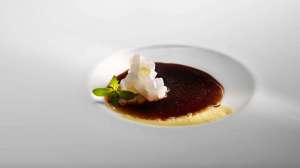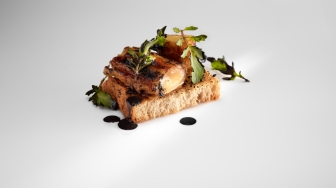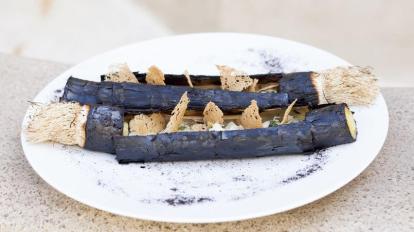
The kitchen at Mugaritz (by Krista – CC license)
When you look at what Michelin-starred top chefs are doing these days, it looks like everyone is into burning food. Ash is on the menu at NOMA, with celeriac rubbed in hay ash and cooked in salt-crust pastry and at MUGARITZ, with an interesting dish of brined squid and ginger, garlic paste and a broth of burnt vegetables, as well as a grilled toast of bone marrow with herbs and radish ash.

Mugaritz – Dices of brined squid, ginger garlic paste and a broth of burnt vegetables
At NOMA, MUGARITZ and EPICURE, and some others, burnt leeks can be found on the menu, as the humble leek appears to be one of the most “burnable” products available. Heston Blumental makes hay-smoked mackerel, layering hay and mackerel fillets in a fish barbecue clamp and then blowtorching the hay-fish sandwich…
Danish chef Christoffer Hruskova does beef fillet in burnt hay. He burns 500g of hay until black, blends it into a fine powder and rolls his cooked fillet of beef in the hay.

Mugaritz – Grilled toast of bone marrow with herbs and radish ash
Using a slightly less direct approach, Pascal Aussignac, at CLUB GASCON, makes a juniper ash flavoured olive oil. He roasts 10g of juniper berries, uses a blowtorch to make juniper ash and then mixes it with 400ml of olive oil.
Tom Sellers, at STORY, does a dish of burnt onion, apple, gin and thyme.
Clément Leroy, at AUBERGE DU JEU DE PAUME (2 Michelin stars), cooks “burnt mackerel & pink radish”. The fish is marinated in salt and vinegar before being lightly blowtorched. The flavor is more progressive than if the flesh had been smoked and the product retains its almost raw and unadulterated nature.
“It is a technique of Japanese origin named yakisaba, explains Leroy, yaki means “grilled” and saba “mackerel”.
Finnish chef Mickael Viljanen, at GREENHOUSE, uses burning branches of juniper for cooking shellfish on. He also burns liquorice root until it turns amberish and roast carrots on it. As he says, “There’s so much you can do. There are no rules. Last year I got some reindeer moss and smoked that with hay and it smelt like the woodland when it came out with the venison.”
At YLAJALI (Oslo), the menu includes (or included as the restaurant is apparently closed) three “burnt” dishes: grilled leek, hazelnuts, cress & löjrom with Røros sour cream; quail eggs glazed in brown butter and leek ashes, with potatoe and leek ash chips; and mussels baked with hay (which makes me think of picnics on the beach in Brittany, with mussels carefully positioned in a single layer on a plank, then covered in hay or straw, which you set fire to).
At EPICURE (Hotel Bristol), Eric Fréchon (3 Michelin stars) cooks “grilled leeks from Ile-de-France, seaweed butter, tartare of oysters, white pear, spring onion and lemon”. 
Huge leeks, as black as charcoal, are used as containers and contain a mix of the leek’s creamy pulp, whole oysters, oyster tartare, spring onions and toasted rye bread.
To round things off, here’s an interesting little recipe which I encourage you to try: Burnt onion butter
Chop a small onion, season with salt and pepper and cook, stirring occasionally and adding water if necessary, until dark brown and very soft. Let cool. Mix the butter and caramelized onion, season with salt and transfer to ramekin, smoothing the top. Meanwhile, oven grill sliced onions on a baking sheet, turning occasionally, until dry and completely blackened. Once cool, grind to a powder and finish by dusting the butter with your burnt onion powder.



